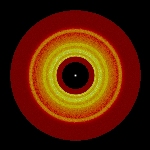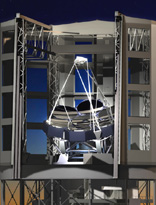| GMT & Planet Formation | ||||
|
Scheduled for completion c. 2016, the GMT will be the largest ground-based optical/infrared telescope ever built. Equipped with innovative adaptive optics (AO) systems to reduce blurring from the atmosphere, the GMT will enable us to acquire the first images of newly-formed Earth-like & gas giant planets and the debris that accompanies planet formation. The GMT may also yield direct images of older gas giant planets around nearby stars. As a member of the GMT Science Working Group, I worked with several colleagues to outline the science mission and capabilities of the GMT. This work culminated in the successful conceptual design review held in February 2006. The links below summarize some predictions for detection of exoplanets and debris disks with the GMT. |

GMT can detect molten Earths
around nearby young stars.
| |||




